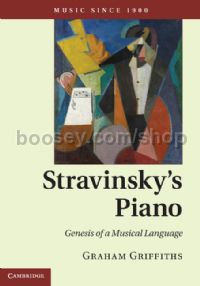Stravinsky's Piano
Stravinsky's Piano
* Estimated price converted from UK retail price
Stravinsky's reinvention in the early 1920s, as both neoclassical composer and concert-pianist, is here placed at the centre of a fundamental reconsideration of his whole output – viewed from the unprecedented perspective of his relationship with the piano. Graham Griffiths assesses Stravinsky's musical upbringing in St Petersburg with emphasis on his education at the hands of two extraordinary teachers whom he later either ignored or denounced: Leokadiya Kashperova, for piano and Rimsky-Korsakov, for instrumentation. Their message, Griffiths argues, enabled Stravinsky to formulate from that intensely Russian experience an internationalist brand of neoclassicism founded upon the premises of objectivity and craft. Drawing directly on the composer's manuscripts, Griffiths addresses Stravinsky's lifelong fascination with counterpoint and with pianism's constructive processes. Stravinsky's Piano presents both of these as recurring features of the compositional attitudes that Stravinsky consistently applied to his works, whether Russian, neoclassical or serial and regardless of idiom and genre.
Features
• Proposes a new understanding of Stravinsky: as a composer who consistently used the piano to mould and to unify his contrasting musical idioms – Russian, neoclassical and serial
• Traces Stravinsky's entire creative path across seven decades: from the fragment Tarantella of 1898 to the (unpublished) Bach arrangements of 1969, written when the composer was eighty-seven
• Presents an unprecedented selection of sketch materials in a fresh evaluation of several of Stravinsky's major works, including The Rite of Spring, Sonate pour piano, Symphony of Psalms, Concerto for Two Solo Pianos, Symphony in Three Movements and Movements for Piano and Orchestra - as well as several rarely-considered miniatures such as the early song 'Pastorale' (and its later instrumentation), 'The Owl and the Pussycat', and the posthumously published 'Lied ohne Name für Zwei Fagotten.'




